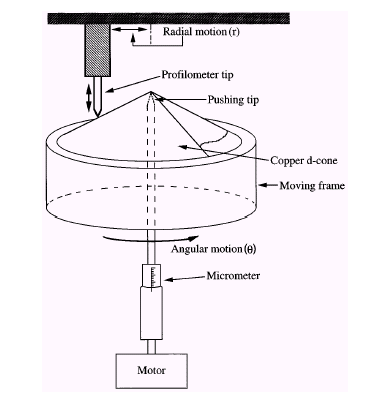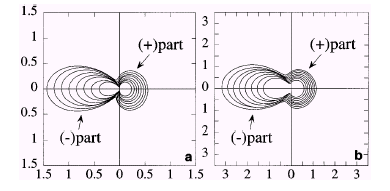
Experimental study of developable cones
Collaboration with
Francisco
Melo
and
Sahraoui Chaieb
Abstract
We investigate developable cones (d-cones) topology. From profilometer measurements, we find that the singularity is never point-like for a sample of finite thicknesses; the singularity is crescent-shaped. Measurements of the sheet local curvature reveal that the d-cone tip is rejected by a distance which characterizes the singularity size. High deformations of the d-cone lead to a plastic regime associated to a decrease in the singularity size.
Experimental configuration
The d-cone is obtained on a thin circular plate (copper, brass, steel or transparencies) by pushing a round tip centered at the principal axis (Fig.1). We keep the sheet border free to move in a circular rigid frame. A profilometric tip, mounted on the active part of a position sensor transducer, makes possible to measure the profile of the deformed sheet. A miniature load cell is mounted under the pushing tip so as to perform force measurements.

Fig.1: Experimental setup.
Resulting plate deformation
Because of geometrical frustration, the deformation of the plate is not homogeneous: a part of the plate loses contact with the frame, giving rise to a concave region [(-),Fig.2]. The angle 2q0, made by the (-) part in the polar direction and over which the d-cone loses contact with the frame, is found to be well-selected and independent on the tip displacement. We find experimentally 2q0 = 110 deg. This value is accounted within 10% by a simple elastic model, minimizing the bending energy, which gives 2q0 = 120 deg.

Fig.2:
Eye bird
view of
the
deformed
plate.
In the (+)
region of
the plate
remains in
contact
with the
frame,
whereas it
loses
contact in
the (-)
region.
Analysis of the plate profile (Fig.3) shows that the singularity is rejected at finite distance from the point where the normal force is applied. The detailed geometrical characteristics of the singularity are discussed in the following publication. More on the subject can be found in subsequent publications by S. Schaieb and F. Melo.

Fig.2:
Profile
(vertical
displacement)
of the
deformed
plate in
polar
coordinates.
The force
is applied
at the
center
(0,0). The
different
lines
correspond
to
profiles
z(q)
at a given
distance r
from the
center.
The lines
corresponding
to the (-)
and (+)
parts of
the d-cone
converge
to two
different
points and
not to the
center;
that
proves
that the
singularity
escapes
the plate
and is not
point-like.
Related publication
Experimental
study of developable cones,
Chaïeb S., Melo F. and Géminard J.-C., Phys. Rev. Lett. 80
(1998) 2354.